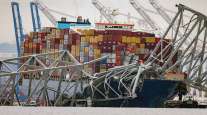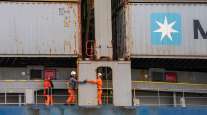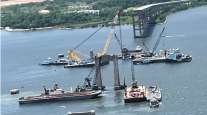Associated Press
Designs Unveiled for Replacement of Baltimore's Key Bridge
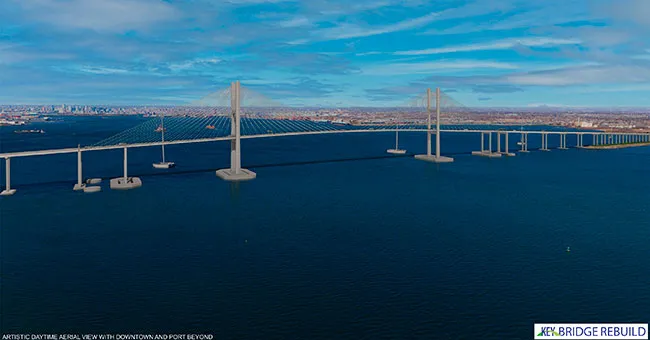
Rendering of the replacement of Baltimore's Francis Scott Key Bridge, with downtown Baltimore on the left and the Port of Baltimore on the right. With its graceful outline and delicate design, officials said the new bridge will modernize Baltimore’s skyline. (Office of the Governor of Maryland via Associated Press)
[Stay on top of transportation news: Get TTNews in your inbox.]
SPARROWS POINT, Md. — Almost a year after the deadly collapse of Baltimore’s Francis Scott Key Bridge, Maryland officials on Feb. 4 unveiled their designs for its replacement, which will be taller and better protected against ship strikes.
Construction of the state’s first cable-stayed bridge could be completed in 2028 and cost about $1.7 billion.
With its graceful outline and delicate design, officials said the new bridge will modernize Baltimore’s skyline, becoming a symbol of resilience, progress and economic growth. The design features two towers with cables radiating down to the deck.
“This is a great day for the state of Maryland,” Gov. Wes Moore said at a news conference. “But it’s not lost on me that today’s triumph was born out of tragedy.”
The original Key Bridge, a 1.6-mile steel span at the mouth of Baltimore’s harbor, took five years to construct and opened to traffic in 1977. It connected various port-oriented industrial communities around Baltimore and allowed drivers to easily bypass downtown.
Today I am proud to join @LtGovMiller and our state and local partners at Tradepoint Atlantic to unveil the new design of the Francis Scott Key Bridge.
We will rebuild the bridge to show once again what it means to be #MarylandTough and #BaltimoreStrong. https://t.co/jafHQafNNc — Governor Wes Moore (@GovWesMoore) February 4, 2025
The bridge was destroyed when a massive containership lost power and slammed into one of its supporting columns. The March 26 collapse killed six construction workers who were filling potholes when the structure crumbled beneath them. Baltimore’s port was closed for months after the collapse, and increased traffic congestion remains a problem for drivers across the region.
Officials quickly promised to rebuild the bridge — a long-standing Baltimore landmark and vital piece of transportation infrastructure.
Demolition of the remaining pieces will take place this spring, with construction of its replacement to follow, officials said.
This is a great day for the state of Maryland. But it’s not lost on me that today’s triumph was born out of tragedy.
Wes Moore, governor of Maryland
Image
They held the news conference at Tradepoint Atlantic, a shipping hub in the Port of Baltimore that played a major role in cleanup and recovery efforts following the collapse. The facility is revitalizing the site of a former Bethlehem Steel plant just northeast of Baltimore as maritime shipping continues to fuel the regional economy.
“Maryland is a bridge between America and the rest of the world. We get cars from Michigan out to market. We bring sugars and spices to Louisiana. We haul farm equipment from the East Coast deep into the heartland,” Moore said. “Commerce and trade are the bedrock of our state, and we will continue to make investments that honor our tradition.”
In August, the state awarded a $73 million contract for the first phase of the rebuild to Kiewit Infrastructure, a major construction and engineering firm.
Officials said the project would advance in two phases, with the first focusing on the design work and other necessary steps before construction begins. Moore promised to “employ many Marylanders” throughout the process.
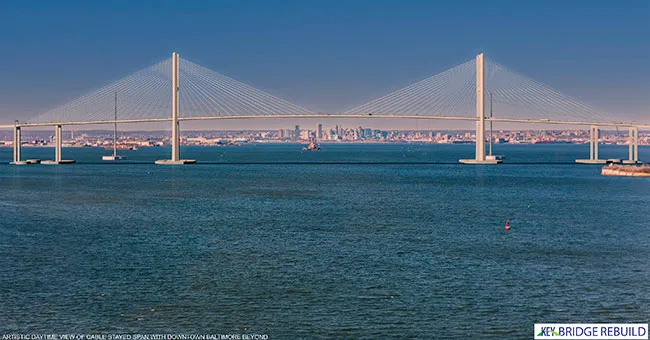
Rendering of the bridge design with downtown Baltimore in the background. The federal government has agreed to cover the full price tag for rebuilding. (Office of the Governor of Maryland via Associated Press)
Maryland Transportation Secretary Paul Wiedefeld said the design will include the latest in pier protection technology, which has become increasingly important as ships keep getting bigger to carry more cargo. The bridge will also be taller to provide more clearance. He said the plans were developed with the project’s cost and construction timeline in mind.
“While this is a beautiful bridge, it will also be a working bridge for a working city,” Wiedefeld said.

Wiedefeld
The federal government has agreed to cover the full price tag for rebuilding. Congress recently passed a spending bill that included a funding provision for the project.
Officials have said they expect that federal taxpayers will eventually be made whole through insurance payouts and damages, but that could take a while. A sprawling civil case will ultimately determine the assignments of liability in what could become one of the most expensive maritime disasters in U.S. history.
The National Transportation Safety Board has not yet released its final report on the collapse, though officials said a loose cable in the ship’s electrical switchboard likely contributed to its power issues. Federal agents boarded the cargo ship Dali amid a criminal investigation last year.
Want more news? Listen to today's daily briefing below or go here for more info:



